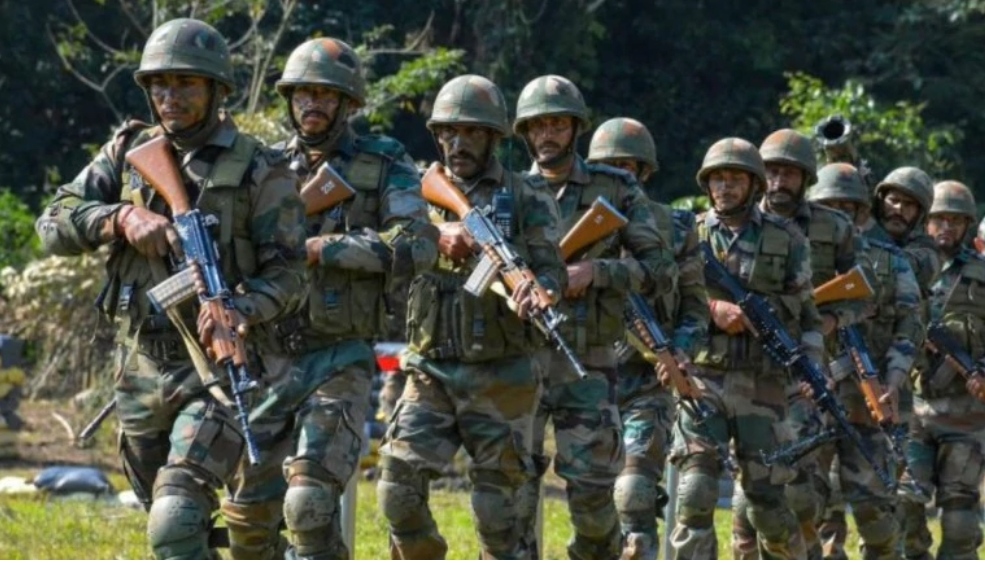Finally It Seems Government Is Listening : New Recruitment Model For The Armed Forces ?
 Over time many articles have appeared on Indianpolitics.co.in recommending a new model for recruitment to Armed Forces, so as to keep the forces young and also reduce the pension bill to the minimum.
Over time many articles have appeared on Indianpolitics.co.in recommending a new model for recruitment to Armed Forces, so as to keep the forces young and also reduce the pension bill to the minimum.
The model would have many other benefits. Link to articles urging the Government to lay down a policy of this kind are given below :
Chief General To meet Army Commanders to discuss Restructuring
Deft Planning By Defence Forces Leading To Right Bang For The Buck Makes Many Speechless
Now as per news, the Army headquarters is considering two additional models for recruitment in the future.
The first model is to make direct recruitment into both Officer Cadre and Other Ranks for a period of just three years in addition to a new formatted training period. This model may be called “ Tour of Duty “. As general conscription is neither suitable nor desirable from the Indian Armed Forces point of view, this is a much better model. Under this those within the prescribed age limit can voluntarily serve in the Army for a temporary period of three years.
These volunteers will be those who want to spend a few years in the Forces for pure adventure and thrill and later move on to a Civil calling of their choice.A weightage can be assigned to this service which will be counted when they apply for any Government or Public Undertaking Job. They will also be given some generous gratuity.
Vide second model all those recruited by Central Armed Police Forces (CAPFs)after basic training report to the Army and after due screening serve for seven years, before being transferred back. Officers Will be put through the SSB, right after their UPSC selection, get trained at OTA and then serve for 5 yo 7 years before going back to respective CAPF.
The above two models will not only ensure that there is no shortage of Offices / Other Ranks in the Defence Forces but will also keep the Forces young. This manpower will also remain fully motivated during the Short Colour service period.
Presently the defence pension budget has ballooned after the ‘One Rank One Pension’ (OROP) scheme came into effect and has crossed even the pay budget of those serving.
However once the two models kick starts then slowly 30% of the Forces should be from these entries. This will place no pension burden and over a period will reduce it by 30%.
Currently, the only option for officers apart from regular permanent commission into the armed forces is the short service commission, in which officers are recruited for a period of 14 years. A large number of short service commission officers eventually opt for permanent commission, subject to eligibility. Similarly the only option for other ranks is colou service of 15 years.
According to Army sources, the Tour of Duty for Officers will be akin to “three years’ short service” and three years ccolor service whose pilot project will be for a limited number of vacancies.
Once tested on around 100 officers and 1,000 jawans in the first go, then vacancies may be increased. Later it may be opened by the government for the Navy and the Air Force also.
“This will attract youth to join the armed forces, because it will not only give them a good experience of serving for a limited duration, but also a good remuneration, and they will be relieved with a lump-sum amount, aside from other perks and benefits which come with the service,” said an officer.
It can be a “lucrative” option because apart from gaining military experience for a limited period, personnel will be free to pursue another career after three years.
“Even major corporates would welcome young, military-trained professionals instead of college freshers, and these professionals would have an edge over others while getting into another career, or even in institutions offering a MBA degree because of the work experience they will gain,” the officer added.
Sources said while opting for this model will be voluntary, the government could add additional perks for those who opt for it, such as being given preference in post-graduate courses or employment in security or administrative jobs in the government sector.
In case of a battle casualty, Tour of Duty personnel would be given the same benefits as regular officers, such as liberalised family pension, ECHS facility, gratuity, and ex-servicemen status.
If implemented, the Tour of Duty model would not only bring an “exponential” reduction in defence pensions, but could make for a more attractive career option than SSC, sources said.
“Moreover, the job would offer attractive pay and allowances as compared to what fresh graduates are offered in other jobs,” the officer quoted above said.
The proposal states that the cumulative approximate cost of pre-commission training, pay, allowances, gratuity, proposed severance packages, leave encasement and other costs is nearly Rs 5.12 crore and Rs 6.83 crore respectively on a SSC officer after his retirement from service after 10 and 14 years.
It adds that the overall cost goes up even further as 50-60 per cent of the SSC officers opt for Permanent Commission and continue in service till 54 years and also get pension benefits on retirement.
“Similar costs for those released after a three-year ToD is just Rs 80-85 lakh,” the officer said.
In case of jawans, that the prospective lifetime savings of just one jawan is Rs 11.5 crore, it estimates. It says the savings for only 1000 jawans could be Rs 11,000 crore, which could be pushed into the modernisation of the Army.
Inverse Induction
The Inverse Induction model will look at bringing personnel recruited by CAPFs into the armed forces’ fold for about seven years, before they go back to their respective recruiting organisations.
There is an existing proposal that retired armed forces personnel be recruited by the CAPFs. But the model under consideration would flip things around.
A second senior Army officer said the Inverse Induction model will not only save on defence pensions, but will also help in training personnel better.
“Their tenure in the armed forces will provide the CAPFs with trained, battle-hardened personnel. They can also be recruited by other understaffed departments like Home Guards, Civil Defence Corps, the National Disaster Response Force (NDRF), and other security agencies,” this officer said.
The Takshashila Institution’s 2019 discussion document had stated that if, over time, 10 per cent of the total strength of Indian armed forces, meaning about 1.2 lakh personnel, are brought in through the Inverse Induction method, the pension bill reduction in year 15 would be Rs 6,468 crore.
“In year 16, the savings will increase to Rs 6,662 crore. In this way, the pension expenditure saved every year will keep rising,” the document stated.




